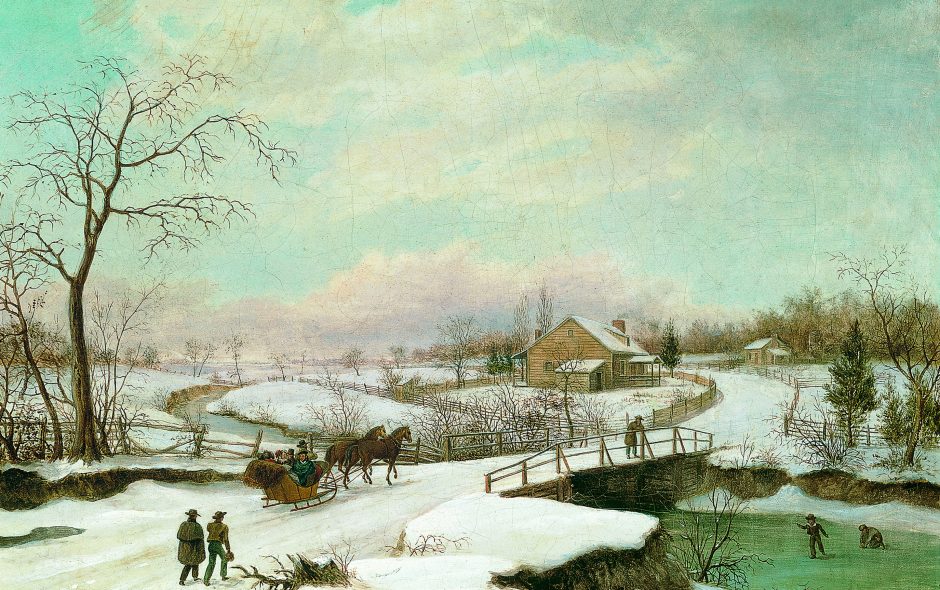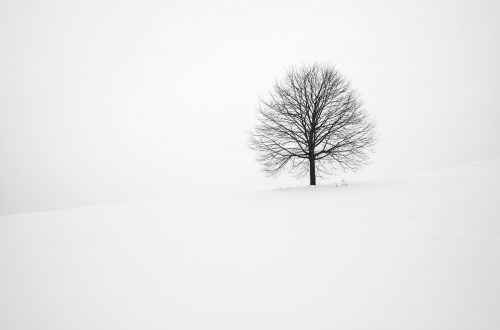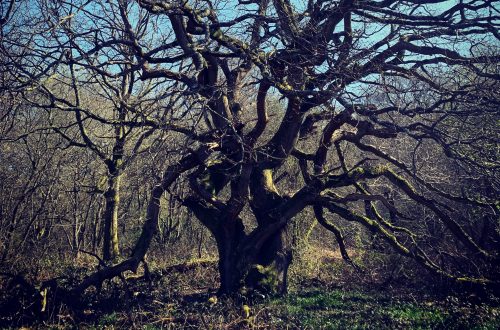Reflections on a painting.
Cold air has laid herself, softly, gently, on this place for many days now. With a stillness, with a gentleness, and a sharp, clear iciness, she has changed everything. The clouds, the snow are white, but the air, she has a whiteness too – a clear, sharp whiteness that flares in the eyes.
There is a place here, a place where river and road cross, where the way of nature and the way of the human gently fold around each other.
The river has been frozen for many days now, has become a path, just like the road. Both can be walked on, be played on, both offer support. River for the children; road for the people, the horses, the cart.
And the meeting of road and river in this landscape, by means of the bridge, gathers a world around it. The fences, the trees, the houses, the sky, the clouds arrange themselves around the meeting place, somehow shift their relationship to it, and each other. In that moment of gathering, in that adjustment of relating, there is the possibility of an opening up in the gaze of the watcher.
I watch, though the painting, and through time, through the brush of paint, and through the artist, and I am present to and part of this gathered world.
The tall tree by the roadside is a watcher too. Its treely awareness inclines to the hunched humans in the cart, and the spritely prancing horses as they pass beneath it.
And the air, oh air, painted in exquisite detail by the long-dead painter. Filling the space above the river, the road, the bridge, expansive up, up into the ether – so cold, so white, so still. And under the bridge, darker, lurking, pushing fingers into every cranny of stone and wood and plant. And in the mouths of all the people – warmed, wetted, rippled by their breath. In the bright places it shines like glass, and in the dark folds close to the earth, it holds the shadows, with a soft fist.
There is a human narrative here too. Children playing in the joy of a winter day. The idle watcher on the bridge, a parent? A passerby? The couples in the cart taking the air in this world of beauty. The couple striding briskly, and to what end?
And there is a wider, bigger story too. The expanse of the land, the presence of the sky, the upthrusting of the trees, the stillness of the river, the unseen birds and animals, the myriad of insects, the lurking fish. This is a vast field, a grand moment of being.
And I sit in my kitchen, the coldness of the air wakens the hairs on my exposed forearms. The train rumbles by beneath me. The weekend’s frost and ice has gone from my world now. But, as I gaze at the picture, it lingers in my experience still.
All these things gather to me, in this ancient room, through this printed picture, lying on the pine table between my elbows.
And what of all this? To what end? If, indeed, an end is even a useful thing to enquire after.
What is the lure of these old paintings that bring landscapes now long gone to life? What is important in the intentions, the attentions and art of these long-gone painters that feels like a portal for today?
They invoke a place, a moment. I want to avoid using the word “re-enchant” but they do allow the natural world to presence with an open aliveness that shifts the human presence to a smaller place, sets up the human in a wider field of being. Even with this picture, where the human presence has an intended focus, it doesn’t take much to pull back and widen the lens of perception, so the wider natural context becomes the larger thing. The wider field has a presence that engulfs the human even though the people are not as small as in a Chinese painting. And yet the human action is vital in causing the place to arise. In a perfect Heideggerian moment, the bridge passing over the river creates the place that anchors the whole felt sense of the whole. Even the people going about their various activities, in the end, contribute to the bridge being itself and thus causing the whole scene to open up.
So I guess the helpfulness in these images is that, even if the intentions of the painters has now become outdated, their work gives us some material to experiment with in encountering the world, places, moments with a shifted mode of attention.
The painting is Thomas Birch’s Philadelphia Winter Landscape c. 1830 – 1845



